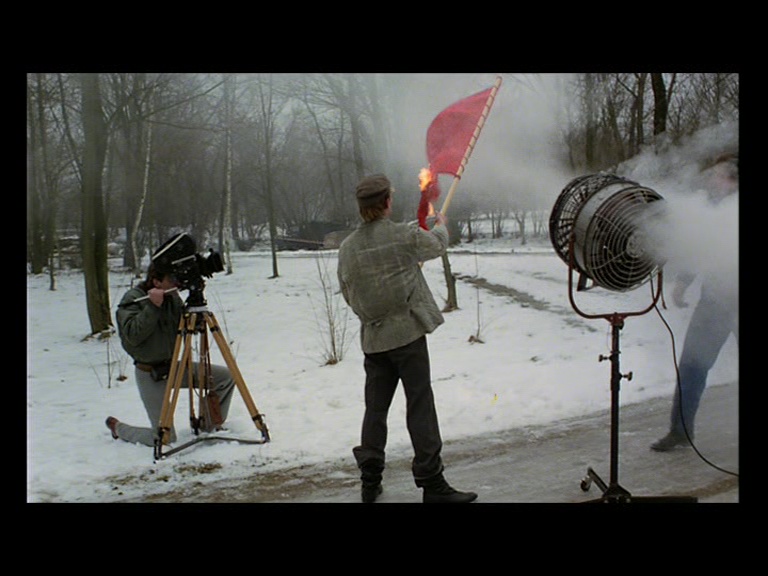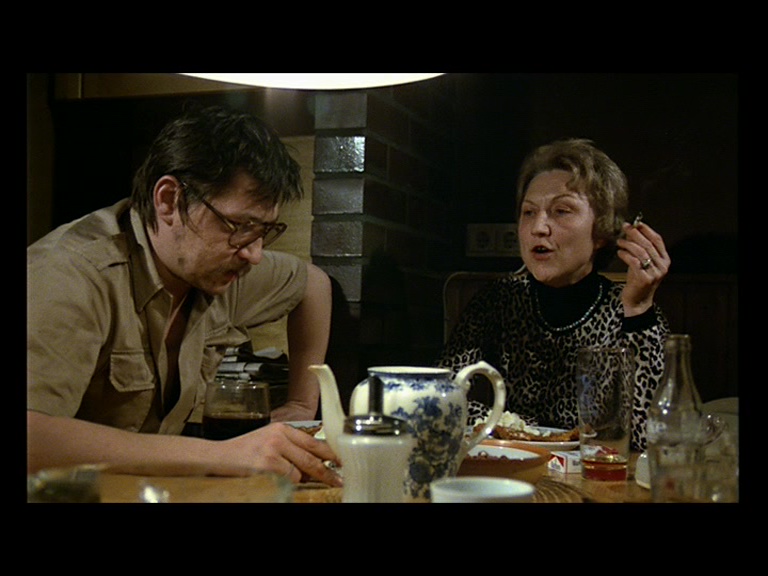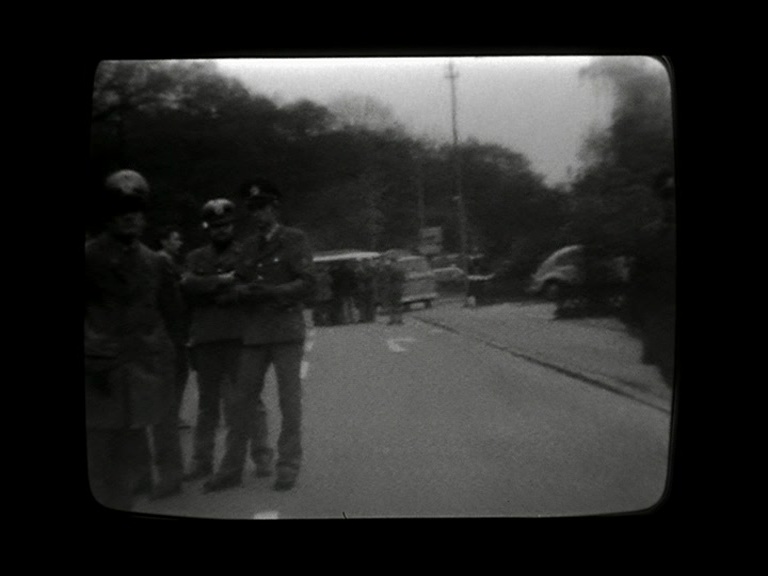Teaching Germany in Autumn
Tyler Schroeder
The penguin chick was an unintentional but appropriate metaphor for my stage of development as an instructor the day I guest-taught a class session on the 1978 omnibus film Germany in Autumn (Alexander Kluge, et al.). Flippers pinned to the sides of its fluffy little belly, it also didn’t know what to do with its hands. Morgan Freeman narrated my trepidation over a classical piano soundtrack: “In time, after being perched atop their mothers’ feet for a thousand paces, like a child learning to dance on her mother’s shoes, the chick takes his first steps alone.” This clip began my morning’s work of familiarizing the class with the ambivalence of leftist terrorism in the West Germany of the late 1970s, a conversation that I hoped would culminate in fertile reflection on the incommensurability of history to documentary representation. It was the second guest lecture I’d given in my time as a teaching assistant. I had chosen Luc Jaquet’s 2005 documentary March of the Penguins to demonstrate the expository documentary mode and the voice-of-God audio style. “And Morgan Freeman actually played God!” I quipped, referring to Bruce Almighty (Tom Shadyac, 2003), which was in theatres when the freshmen in our class were kindergartners; they greeted my clever aside with confused half-smiles.
Our students now confronted their second film of the New German Cinema; they had already seen Ali: Fear Eats the Soul (Rainer Werner Fassbinder, 1974), paired with All That Heaven Allows (Douglas Sirk, 1955), as we covered mise en scène several weeks earlier. The instructor of record had selected Germany in Autumn to represent the documentary, and, our screening had been prefaced with an extended introduction by the knowledgeable Germanist teaching a parallel section of the course. Our students came to the film understanding that Germany in Autumn was a collaborative project responding to a specific historical period, and a dawning comprehension that it was a stylized and partially fictionalized work that related to documentary modes in complex and conflicted ways.
In an encounter with such a film, what can an inexperienced TA bring his students to do more effectively than a more seasoned instructor? At the least, I can startle and worry them through my mere presence and the oddness of my affect. Whether the intrusion of this young man with his awkward pauses, scripted jokes, and families of penguins glowering over his right shoulder enhanced or complicated our discussion of documentary film in any way, I’ll admit I’m not sure. The remainder of this essay will recount no masterstrokes of pedagogy on my part, nor any understated brilliance from my students. Instead, searching my original preparatory materials, the pre-class writing of our students, and my modest memory, I will recount an attempt to be pedagogically useful, to make my guest lecture not merely a training exercise for a young teacher but the fulfillment of our course’s promise to train young eyes and ears in critical film reception. What did my students show me was to be gained from the oddness of my presence at the lectern, and what did they demonstrate was lost in the change? Eight weeks into our project of recalibrating their faculty of critical vision, what were the consequences of their looking at me as they worked through their viewing of Germany in Autumn? I wish to propose three factors as the clearest successes of this session, the ones that most accommodated and did justice to Germany in Autumn while remaining true to our desire to introduce documentary film more broadly. First, I parsed the film in advance, to make its chaotic form more readily discussed; second, pre-class writing assignments in the form of discussion-board posts allowed me to use the more refined insights that came out in writing to animate the more impulsive intellectual atmosphere of class discussion; third, my presence, like the film itself, forced the students to develop their own conclusions about what the hell was going on.
The bit of preparation that I’d done that, by far, contributed most clearly to the conversation was one of the simplest, even the most banal. The instructor of record had requested that I parse out the film’s episodes and interludes into a list, order them chronologically and label them by the filmmakers involved. This slide of bullet points provided an armature for the students’ analytical discussions tracing the film’s various plots, historical arguments, and swerves into reportage, rhetorical montage, or stylized, fictional drama. Idealistic young teachers-to-be like me would do well to remember to emphasize simple interventions like this one; they’re not sexy, but they give a class some ground to stand upon.
Compared to my remarks on the animating principles of the New German Cinema (which included a whirlwind trip through newsreels, Riefenstahl, Trümmerfilm and Heimatfilm to the bucolic kitsch paintings on Emmi’s kitchen wall in Fassbinder’s Ali and the Mercedes-Benz banners in Germany in Autumn), this was a simple task, tedious to prepare and simple to perform. Working through this list in class nonetheless became a deeply empathic task: no problem weighed more heavily on the students, in that week’s written and verbal discussions, than the disorientation Germany in Autumn had wrought upon their conception of cinematic documentary depiction. The film upended what Bill Nichols calls their “commonsense assumptions about documentary,” which focus around documentary being about people, places and times.[1] Germany in Autumn doesn’t describe its place, time, and characters—it instantiates them, affectively, in film time. We’re not in the temperate, expository climes of Antarctica anymore, and a Ken Burns miniseries on the Red Army Faction would likely include few detours into neo-noir fiction.
An interwoven bundle of questions had emerged from the discussion board. Why was this film a documentary, and was it an outlier within that category? How did its form relate to the political situation it articulated? How did it justify its most scripted moments, and conversely, how should one account for the ways in which historical visual and media objects, like television programs, newspapers, paintings and newsreels, are stitched into and between the film’s episodes? My outline of the film’s various structures of action finally served as more than a clarification of an intricate set of images. It mapped the film’s fissures and discontinuities and evinced the both collective quality of its authorship and its unifying patterns, something Marc Silbermann refers to as the “structure and rhythm” created by editor Beate Mainka-Jellinghaus, which renders the film “a formal vehicle by which the spectator’s habitual ways of seeing history are disrupted.”[2] This simple explanatory measure permitted us to more carefully linger in the uncomfortable gap between fact and fiction, to dwell without settling on an epistemic limit.
Those of us who have studied film and visual media for years have left well behind us the initial wonder of discovering that it is impossible to draw a bright line between fiction and non-fiction film; something along the lines of “all representation is fiction” has grown into a tired truism. Teaching an introductory class session on documentary film, however, requires people like us to retrieve and remystify this problem. If the film outline was to provide a map, this map referenced not only the film but the uneven terrain of the students’ preparatory comments on the discussion board. With titles like “Documentaries are not Documentary” and “What is even real anymore,” these thoughts showed both difficulty and exhilaration emerging from familiar representational problems. While one of the most frequent sentiments was an awareness of the contructedness of supposedly nonfictional representation, each student came into this awareness in a different way. Some students noted their surprise at discovering that this face, the speaker of what they perceived as highly scripted lines articulated by well-produced editing, was the same Rainer Werner Fassbinder with whom they had engaged as a more abstract authorial presence in their midterms on Ali; and moreover, that Lilo Pempeit was in fact his mother:
Others seized initially on the film’s more clearly non-fiction moments, such as the original footage of the funerals of Mercedes-Benz executive Hans-Martin Schleyer and of that of the RAF members Andreas Baader, Gudrun Ensslin and Jean-Carl Raspe. One of the comments that startled me the most came from a young non-major whose insights on the discussion board had often seemed somewhat blunted by a desire to demonstrate her enjoyment of the course content. Rather than take up the “documentary as fiction” route that seemed an intuitive conclusion to many of her classmates, she began by writing that Germany in Autumn was “obviously” representative of the documentary mode, but in being so “pushed the definition to a whole new level” insofar as its “story jumped around.” Such an evaluation—although it demands clarification for which I was reluctant to ask during class time—nevertheless performed important preparatory work for addressing the class. Rather than only credulity—that the film listed under the week’s rubric of “Documentary” would represent that genre unproblematically, and that any deviations from the norms she associated with documentary reflected her inexperience rather than the film’s own liminality—I find this student’s response to offer a veiled expression of the problems of film classification. Thanks to her, I could ask my students what made this film a documentary, during my lecture, in two different ways: where does this film stop being a documentary, and where and how to it instead extend the possibilities and conventions of non-fiction? The students responded with a full spectrum of ideas: one thought the film was a documentary insofar as it included footage of historical events; another thought it was a documentary insofar as the staged interviews with Fassbinder may have reflected sincerely held beliefs; another still thought it was improper to call the full film a documentary because of its inclusion of fictional sequences, but nevertheless acknowledged its power as a historicized staging of a time and place.
By contrast, another student, one with very different habits of thought, linked the aesthetic of Ali to that of the Fassbinder-centered sequences in Autumn. This student made two points in tandem; first, an attention to walls in the mise en scene to create a sense of claustrophobia and emotional limitation, and second, the validity of scripting, editing, cinematography and lighting as interventions to convey emotional truths in an ostensibly non-fiction film (the latter, manifest in many different phrasings, was a frequent refrain among the students, and was likely at least partially prompted by readings like the Nichols that deemphasized the primacy of expository documentary). Finally, at least two students wrote that the film’s changes in style, mode, and authorship worked to recreate not just the factual “content” of the history of Germany in the 1970s, but to give the viewer an experience of the tumult of the time. Summaries of all of these comments accompanied me to class on a yellow legal pad; if I recall correctly, these emboldened the class, more broadly, to talk about the junctures between emotion, spectatorial experience, and the ambivalent category of the historical.
Germany in Autumn was a rich basis for the documentary portion of an introductory film course for the same reason that I, was, I think, at least a passable teacher during that class session. Both film and TA derailed a routine of knowledge practice; it was a chance, as the Brechtians of the New German Cinema would like to have it, of constructing instructive meaning out of an odd and disruptive aesthetic. One other student had written something odd and wonderful about the states of ambivalence engendered by disruption, although I do not remember what she said in class: “aware of the disconnectedness between stories and the inconsistency of style (created by multiple directors), I become no longer eager to find a main thread; instead, I peacefully sit back and digest whatever the film tells me, which to me is a newly-discovered enjoyment.” Her formulations are probably a little more passive than Kluge would’ve preferred, but if Germany and Autumn and I have brought anyone to linger in ambivalence where they’d looked for fact and authority, we’ve found a measure of success.
Tyler Schroeder is a Ph.D. candidate at the University of Chicago, where he is developing a dissertation on health, medicine, and hygiene in visual and network media in German-speaking Europe.
Notes
Thanks, in general, to the students of Takuya Tsunoda’s section of Introduction to Film at the University of Chicago in Winter Quarter, 2017 and at in particular to those students whose contributions I cited and whose anonymity I must preserve. Thanks as well to my friend and mentor, Kristi McKim of Hendrix College, for giving me the opportunity to publish this piece.
[1] Bill Nichols, Introduction to Documentary (Bloomington, IN: Indiana University Press, 2001), 7-14.
[2] Silberman, Marc. “Introduction to Germany in Autumn.” Discourse 6 (1983), 50. http://www.jstor.org/stable/41389070.




